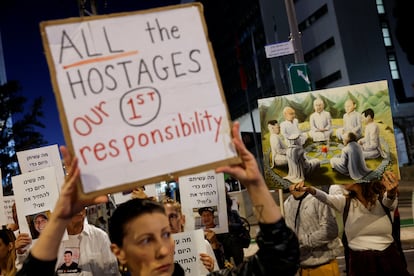Keys to understanding the truce between Israel and Hamas: Weeks of negotiation in Qatar and one hostage for every three Palestinian prisoners
The pact is expected to come into force on Thursday and will allow for the release of 50 Israeli hostages in exchange for the release of 150 Palestinian prisoners. The agreement also includes allowing humanitarian aid into Gaza

Israel has agreed to a truce with Hamas after having refused for weeks any kind of temporary pause in fighting. Under pressure from the families of the hostages and a large part of Israeli society, and after weeks of negotiations mediated by Qatar, Israel’s government and the Palestinian militia have agreed to a ceasefire of at least four days. The pact represents the first respite for civilians in Gaza after 47 days of relentless fighting inside the Palestinian enclave. The agreement includes the exchange of hostages held in Gaza for Palestinian prisoners detained in Israel.
These are the main keys to the agreement.
What does the pact between Israel and Hamas consist of?
The parties agree to a four-day ceasefire in Gaza, which may be extended by 24 hours. In parallel, Hamas will release 50 hostages out of the approximately 240 people of different nationalities they kidnapped during their Oct. 7 attack in Israel (four women have already been released, and the army has freed a female soldier). The 50 hostages will include 30 children and 20 women, eight of whom are mothers. In exchange, Hamas has secured the release of 150 of the approximately 8,000 Palestinian prisoners held in Israeli jails. The Palestinians released will also be women and children. The exchanges, supervised by the Red Cross, will be carried out in phases, day by day. Netanyahu also announced that the Red Cross will be able to visit the remaining hostages in Gaza and provide them with medical assistance.
As part of the agreement, hundreds of trucks carrying aid will be able to enter Gaza through the Rafah crossing, at the Strip’s border with Egypt. These trucks will include desperately needed fuel, which is vital — in the absence of electricity — for the operation of hospitals and for obtaining drinking water. The United Nations warns that, in addition to the relentless Israeli bombardments, the Gazan population is increasingly exposed to epidemics and diseases due to the harsh conditions of overcrowding, lack of hygiene, poor water consumption and insufficient food. These conditions are coupled with the arrival of winter and the absence of a functioning hospital in the north of the Strip, devastated after weeks of air strikes.
When does the truce start and how long will it last?
According to Israel and Hamas, the exchange of hostages and prisoners is expected to begin on Thursday. Hamas assures that the temporary truce will begin on Thursday at 10:00 a.m. local time (3:00 a.m. Eastern Time). It will last four days. However, it may be extended by 24 hours for every 10 additional hostages Hamas releases on top of the original 50, Israel said in a statement. The maximum the ceasefire can last is 10 days, and the maximum number of Palestinian prisoners released will be 300. Israeli Foreign Minister Eli Cohen has said that Israel will receive the first group of hostages on Thursday.
The start date, Thursday, is also conditioned by the 24 hours required by Israeli law for possible appeals to the Supreme Court if any of the Palestinians released from prison have committed blood crimes.
Where was the agreement forged and what countries participated in negotiations?
The agreement has been brewing for weeks behind the scenes, essentially in the Qatari capital, Doha, where Hamas’ political leaders are currently based. The Qatari government is the main sponsor of the pact, but the United States, Israel’s main ally, and Egypt, Gaza’s neighbor with the only functioning border crossing at Rafah, were also instrumental in the negotiations.
What does Israeli society think of the pact?
For weeks, Israeli Prime Minister Benjamin Netanyahu refused to accept any form of ceasefire, even for just a few hours or a few days, to allow humanitarian aid into Gaza. Both Israel and its main ally, the United States, believed that a cessation of hostilities, even if temporary, would allow Hamas to rearm and reorganize. Netanyahu was caught between two internal fronts. On the one hand, he faced the pressure of the families of the approximately 240 hostages who have been held in Gaza since October 7 and who demanded that he pull out all the stops to bring them back. On the other, the more nationalist and extreme right wing of his cabinet continued to pressure him not to give in to what they consider to be the demands of a terrorist organization.
Israel remembers well how the soldier Gilad Shalit was released in 2011 in exchange for 1,027 Palestinian prisoners after being held in Gaza for five years. However, now it’s not just one soldier but 240 hostages, including civilians. With every day that passed, pressure mounted on Netanyahu to secure their release, as the families of the captives — supported by a significant portion of Israeli society — continued to protest the Prime Minister’s inability to bring their loved ones home.
Thus, in the eyes of Israeli society, the three-to-one ratio of 50 hostages to 150 prisoners is viewed as a positive step. Hamas had demanded, in the early days of the war, that all Palestinian prisoners be released in exchange for releasing the hostages.
What’s happened in the past 47 days of war?
Hamas’s October 7 attack, unprecedented in scope and perpetrated on Israeli territory, triggered a war that has been raging for 47 days. Some 1,200 people were killed in Israel by militiamen who razed homes, military barracks and killed more than 200 attendees at a music festival. In addition, some 240 hostages were taken to Gaza, some of whom will now be released thanks to the agreement.
In Gaza, Israeli attacks have killed more than 14,000 people, including more than 5,000 children. In the first three weeks of the Israeli military campaign in Gaza, the bulk of the attacks came from the air, as bombardments. However, in late October, the army began to carry out ground incursions inside the Gaza Strip, which culminated in the definitive invasion of the Palestinian territory on October 27. The Israeli army’s offensive is primarily centered in northern Gaza, where the scale of destruction is immense: Israel’s attacks have hit, in addition to thousands of residential buildings, hospitals, refugee camps, mosques, schools (some of them belonging to the United Nations) and media offices. The Gaza Strip is one of the most densely populated territories in the world, with some 2.3 million people — half of whom are minors — crammed into 140 square miles.
Sign up for our weekly newsletter to get more English-language news coverage from EL PAÍS USA Edition
Tu suscripción se está usando en otro dispositivo
¿Quieres añadir otro usuario a tu suscripción?
Si continúas leyendo en este dispositivo, no se podrá leer en el otro.
FlechaTu suscripción se está usando en otro dispositivo y solo puedes acceder a EL PAÍS desde un dispositivo a la vez.
Si quieres compartir tu cuenta, cambia tu suscripción a la modalidad Premium, así podrás añadir otro usuario. Cada uno accederá con su propia cuenta de email, lo que os permitirá personalizar vuestra experiencia en EL PAÍS.
¿Tienes una suscripción de empresa? Accede aquí para contratar más cuentas.
En el caso de no saber quién está usando tu cuenta, te recomendamos cambiar tu contraseña aquí.
Si decides continuar compartiendo tu cuenta, este mensaje se mostrará en tu dispositivo y en el de la otra persona que está usando tu cuenta de forma indefinida, afectando a tu experiencia de lectura. Puedes consultar aquí los términos y condiciones de la suscripción digital.
More information
Archived In
Últimas noticias
Mexico’s missing people crisis casts a shadow over World Cup venue
Helen Levitt, the photographer who captured the theater of the everyday
The guardians of the meteorites of the Argentine Chaco
Families demand repatriation of bodies of Colombians who died in Ukraine: ‘This war is a slaughterhouse for foreigners’
Most viewed
- Christian Louboutin: ‘Young people don’t want to be like their parents. And if their parents wear sneakers, they’re going to look for something else’
- US sanctions against jailed cartel leader ‘El Marro’ highlight Mexico’s lack of control over its prisons
- Cartels in Mexico take a leap forward with narco-drones: ‘It is criminal groups that are leading the innovation race’
- Liset Menéndez de la Prida, neuroscientist: ‘It’s not normal to constantly seek pleasure; it’s important to be bored, to be calm’
- ‘El Limones’ and the growing union disguise of Mexican organized crime











































